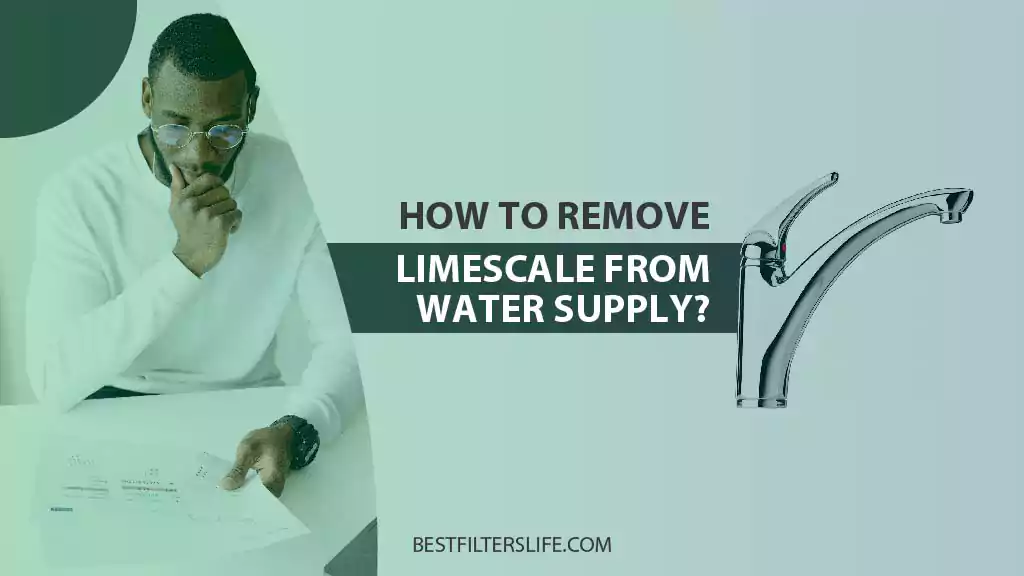Hard water discolor your tiles, home gadgets like kettles, and coffee machines. And you’re unsure how to approach the situation. As an investigator and safety executive, I can tell you which concerns are appropriate for removing limescale.
Studies revealed that 85% of European and US homes are affected by limescale. If it is not cleaned away, the limescale restricts water flow and reduces efficiency. It can be fixed by homemade remedies and even water filters that remove limescale and calcium.
Continue to read this blog!
This article will explore limescale in water, potential health issues with limescale, types of limescale filters, and how to remove limescale from the water supply and tanks.
Let’s continue to learn the cleaning tips!
What is Limescale?
“Limescale is a hard white crust mostly present in your well water.”
Hard water limescale is a chalky, hard deposit primarily of calcium carbonate (CaCO3). It frequently accumulates inside kettles, boilers, and piping, particularly hot water pipework. It’s also common on the inner surfaces of old pipes and other surfaces where “hard water deposits” have flowed as a similar deposit. In hard water springs, limescale can also take the shape of travertine or tufa.
Sources Of Limescale Buildup: Calcium and magnesium minerals in well water build up limescale. Rainwater filters through rocks like chalk and limestones, collecting up hard minerals along the route resulting in hard water stains.
How Do I Remove Limescale From My Water Supply & Tank
Here, I’ve shared the guide into two parts: (a) Tips to remove limescale naturally and (b) You can install water filters to get rid of scale buildup.
Tips to Remove Limescale from Pipes, Toilets, Windows, Shower Doors, Tanks, and Appliances
How to remove limescale from inside pipes? People who value applying the DIY method to clean their homes. I have good news for them on removing limescale from inside pipes, toilets, Windows, Shower Doors, and Appliances. Hard water problems might be difficult to get rid of, but it’s possible with some easy home remedies and the best limescale treatment for the whole house:
- Limescale may be removed using a variety of mildly acidic household goods such as lemon juice and vinegar to clean limescale from a showerhead, taps, tiles, and other smooth surfaces. It will not only eliminate the limescale but will also smell fresh and clean in your bathroom or kitchen.
- In the case of the toilet and glass shower doors, apply the same method mentioned above but wash it with the help of a toilet brush.
- Use a non-precipitating softener tablet in your washing machine. It will keep limescale from clogging your machine’s interior working. It will also aid the detergent in cleaning the garments more thoroughly.
- You can prevent limescale by adding a chemical inhibitor specifically for central heating systems.
- Mix one part water with three parts baking soda to make a paste. Allow it to sit for an hour after rubbing it all over the limescale. Then, using a soft towel, wipe it clean.
Water Filters That Remove Hardness or Scale Buildup
Reverse Osmosis Filters are great for removing limescale, but they also remove all beneficial minerals, leaving the water tasting “flat.” The patented limescale inhibitor then creates a compound with inorganic pollutants, preventing hard scale, staining, and other problems.
You can opt for the whole-house reverse osmosis water for best results.
Water Softeners: Ion-exchange units, often known as home water softeners, remove calcium, magnesium, and other minerals from drinking water. Calcium and magnesium are trapped by resin beads inside the softener and exchanged for sodium or potassium.
The best limescale treatment for the whole house reduces limescale symptoms.
Effects Of Limescale Poisoning
You’ve probably asked yourself more than once if limescale in water is bad for you. Is it safe to drink hard water deposits? Hard water stains contain limescale, which is not hazardous to drink; in fact, some people prefer the flavor of hard water to soft water.
There is no strong health evidence shown; however, you look forward to removing it. And Why should you remove limescale? Because It can bring various disasters:
- According to the NCBI, long-term excess exposure can cause Cardiovascular disease, Cancer, Cerebrovascular mortality, and Alzheimer’s disease
- Loss of water pressure due to the reduced pipe diameter.
- Bacterial growth
- Appliances will require frequent repair or even replacement.
- Replacement of heating pipes.
- Irritation of sensitive skin.
- Dry and dull hair.
- They increase heating expenses due to energy loss in hot water systems.
- Detergents are less effective, resulting in garments that appear dirty even after washing.
- There is a white residue and dull surfaces in the bathroom and kitchen.
Conclusion
Limescale is the product of calcium and magnesium in hard water problems. Water softeners and whole-house water filters are the best limescale treatment for the entire house. You can also easily solve this problem with a simple DIY using lemon and vinegar.
FREQUENTLY ASKED QUESTIONS
Some other questions’s answers for our readers that might be helpful for reading.
Does Boiling Water Remove Limescale?
Boiling hard water is the simplest way to remove limescale from water. When you boil water, the hard water mineral deposits, leaving you with clean, soft water.
What’s the Best Homemade Limescale Remover?
There are two products available to help you get rid of limescale. Use vinegar and lemon for solid deposits around faucets, plumbing fixtures, and washroom. Make a vinegar-lemon solution and use it as needed.
How to Remove Limescale From the Water Dispenser?
Suppose you have hard water minerals that are precipitating out. Soak a paper towel with white vinegar, give it about 20-30 minutes, and rinse it with water.





